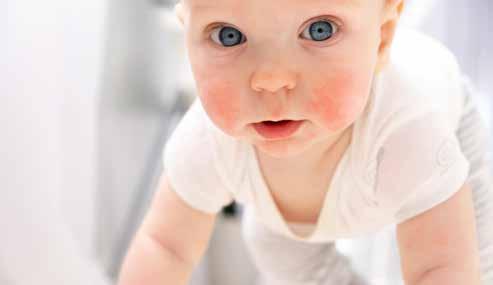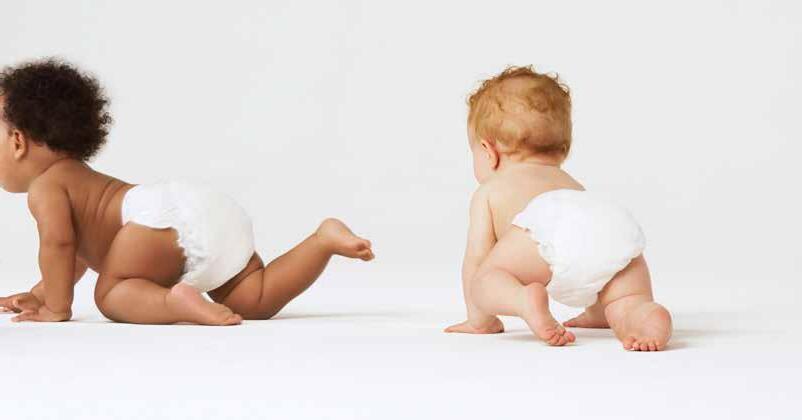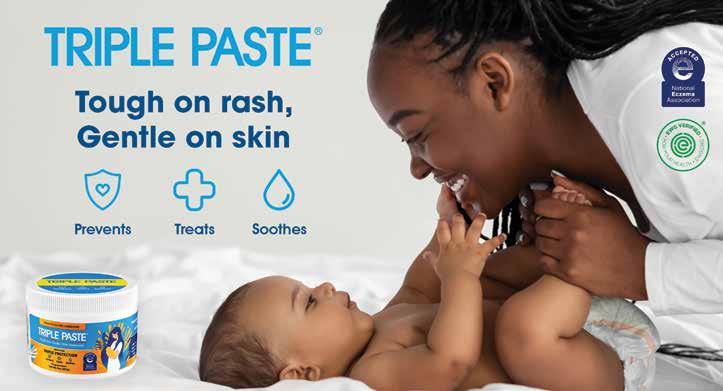Skin Health
June 2024 | www.futureofpersonalhealth.com
“While newborn and infant skin rashes are usually mild, will self-resolve, and are benign, they can nevertheless be anxiety-inducing.”
JiaDe (Jeff) Yu, M.D., M.S., Member, The Society for Pediatric Dermatology Page 02
DESI PERKINS
The beauty influencer and creator of DEZI SKIN shares her top tips for better skin
Read more on Page 06
An independent supplement by Mediaplanet to USA Today
“We know moms want their babies’ clothes to be clean, but they won’t choose a detergent if it’s not gentle on their babies’ skin.”
Kimberly Romine, Laundry Scientist, Dreft Page 07

Decoding Newborn Rashes: A Guide for New (and Experienced) Parents
As a pediatric dermatologist, I experience the joys of seeing newborns daily. Newborns are perfect. While we also want their skin to be just as perfect as they are, sometimes nature has other plans.
There are myriad pediatric rashes that can trigger anxiety in new parents, partly because these are visible. Parents who turn to Google will be confronted with thousands of blogs touting “home remedies” from bathing the child in breast milk to cutting out everything in their diet in case their symptoms are an allergic reaction.
While it may be difficult to discern how to navigate these conditions, the good news is that most rashes in newborns are benign and short-lived.
Neonatal acne (benign cephalic pustulosis)
This is one of the most common rashes we see in newborns. Often presenting within 0-6 weeks of life, neonatal acne appears as little red bumps, pus bumps, or blackheads and whiteheads that appear on the face and can involve the upper chest and upper back as well. In darker skin, the redness may not be easily seen and, instead, dark bumps may appear.
Though these types of rashes are generally mild and can self-resolve within three to six months, they are no doubt anxiety-inducing, especially since it’s on your baby’s face.

Now that your child has this, how do pediatric dermatologists treat it? For most neonates, we reassure parents that this will resolve within a few weeks or months and will not scar. During this time, we recommend gentle, fragrance-free cleansers that are safe to use on young children that we would also recommend to children with sensitive skin. Thick oils can actually make this condition worse through occlusion of the hair follicles and should be avoided.
Diaper rash
While this seemingly catch-all phrase is the bane of parents, pediatricians, and dermatologists alike, there is actually more to it than meets the eye.
The most common type of diaper rash is irritant contact dermatitis caused by urine and stool trapped in the ultra-adhesive, leak-proof diaper on your newborn’s bottom.
The best treatment is to apply copious amounts of diaper cream that contains zinc oxide (the more the better). I often recommend applying very thick layers of diapering cream, akin to what you’d use if you were frosting a cake.
Eczema (atopic dermatitis)
Almost 20% of all children have atopic
dermatitis, and most (80-90%) are diagnosed before the age of 5. Many parents of children I see report their child having eczema “since the moment they were born.”
In infants and newborns, eczema often first appears on the face, especially the cheeks, trunk, outer arms, front of the legs, etc. These eczema spots look like dry, red, scaly patches, and are often itchy.
Most cases of eczema are genetic, with most children having a parent, grandparent, or sibling who also has eczema, asthma, hay fever, or food allergies. While it is true that many children can outgrow eczema, children with more severe eczema tend to have eczema into late adolescence and adulthood.
First-line therapies for infants and newborns include moisturizing the skin with thick emollients, such as petrolatum-based ointments, thick oils like coconut oil or sunflower oil, and other moisturizers — the thicker the better.
While these newborn and infant skin rashes are usually mild, will self-resolve, and are benign, they can nevertheless be anxiety-inducing. Consulting with a pediatrician and pediatric dermatologist is reasonable and recommended.

You can source a local pediatric dermatologist through the Society for Pediatric Dermatology’s “Find a Pediatric Dermatologist” feature at pedsderm.net
Publisher Razelle Amante
02 MEDIAPLANET READ MORE AT FUTUREOFPERSONALHEALTH.COM @futureofpersonalhealth Contact information: US.editorial@mediaplanet.com @MediaplanetUSA Please recycle
Managing Director Gretchen
Production Manager Dustin Brennan Creative Director Kylie Armishaw Cover Photo Credit Marco Roman All photos are credited to Getty Images unless otherwise specified. This section was created by Mediaplanet and did not involve USA Today.
Pancak
WRITTEN BY
JiaDe (Jeff) Yu, M.D., M.S. Member, The Society for Pediatric Dermatology

Proactive Protection for Diaper Rash
According to Mintel, the majority of first-time parents look for products designed for sensitive skin1 and are focused on care for baby’s delicate skin; however, diaper rash can get in the way.
The American Academy of Pediatrics defines diaper rash as any rash that develops inside the diaper area and can occur when skin stays wet for too long.2
“Diaper rash is extremely common for babies,” said Dr. Lindsey Zubritsky, a board-certified dermatologist with extensive training in pediatric dermatology and best known for her skin care knowledge on the @dermguru TikTok and Instagram accounts. “It can also be very uncomfortable, causing inflammation and redness on the soft skin in that is in contact with a wet or messy diaper.”
While there are various solutions to treat diaper rash, choosing the right diaper can help. Huggies® is introducing a new era of skin health with its new Huggies® Skin Essentials™ diaper. The diaper features the brand’s proprietary SkinProtect™ liner that helps absorb moisture and lock away runny mess from babies’ delicate skin. The diaper helps protect against the top two causes of rash; moisture and mess (by managing runny mess).
Dermatologist-approved
Designed with babies’ sensitive skin in mind, the Huggies® Skin Essentials™ diaper has also undergone thorough testing from our team of researchers and engineers. The diaper is dermatologist-approved and helps keep skin clean and healthy — so babies and parents are free to get on with the joys of babyhood. In fact, Dr. Zubritsky counts herself among those dermatologists that approve of the new collection from Huggies®.

“As both a dermatologist and mom, I am always looking for the best ways to protect my babies’ delicate skin. The innovative SkinProtect™ liner featured in the Huggies® Skin Essentials™ diaper helps absorb moisture and lock away runny mess,” Dr. Zubritsky said. “This new diaper
from Huggies® helps keep babies’ skin protected against the top two causes of diaper rash [mess (by managing runny mess) and moisture] and is something caregivers everywhere can get behind.”
There are zero harsh ingredients in Huggies® Skin Essentials™ diapers — they’re free of fragrance, parabens, and elemental chlorine. The diaper also features Huggies® Blowout Blocker and is up to 100% leakproof. It’s available in a range of sizes from newborn to 6.
“Huggies® puts babies and their caregivers at the heart of all we do. We’re proud to use science and innovation to meaningfully impact families’ lives,” said Scott Glenn, vice president of the U.S. Huggies® brand. “The launch of Skin Essentials™ will be a game-changer for the category and is one more way Huggies® helps caregivers navigate the unknowns of babyhood.”
Written
by Huggies®

INTERVIEW WITH Dr. Lindsey Zubritsky Board-Certified Dermatologist, @dermguru

WITH Scott Glenn Vice President, U.S. Huggies® You can find Huggies® Skin Essentials™ Diapers, Wipes and Pull-Ups® Training Pants in stores and online at major retailers nationwide, including Target, Walmart, Amazon and more REFERENCES
1 Mintel, US Disposable Baby Products Market Report, 2023, p. 4
2 American Academy of Pediatrics, Pediatric Patient Education, January 2021

03 MEDIAPLANET READ MORE AT FUTUREOFPERSONALHEALTH.COM Sponsored
INTERVIEW
What All New Parents Need to Know About Diaper Rash
Diaper rash is any rash affecting the skin covered by a diaper. Other names for diaper rash are “diaper dermatitis” or “napkin dermatitis.”

Diaper rash is usually caused by wetness and friction. Urine and stool can cause even more irritation, and this causes the skin to break down. Products used to clean the skin can sometimes add to the irritation.
Once the skin under the diaper becomes irritated, germs like bacteria and yeast can infect the skin and worsen the rash. In some cases, other skin conditions, like psoriasis, can be worsened or triggered by diaper rash.
Who gets diaper rash?
Diaper rash is most common in newborns and infants, but anyone who needs to wear a diaper can develop this rash. About one-half of all babies develop diaper rash at some point during the first year or two of their life.
Diaper rash is most common between 9 and 12 months of age, and is more common when the child is having frequent bowel movements or diarrhea. An illness, a medication like an antibiotic, or a change in diet can cause changes in bowel movements.
Preventing
diaper rash
The two best ways to prevent diaper rash are to change diapers frequently and use super absorbent disposable diapers to keep the skin under the diaper as dry as possible.
Some other keys to preventing diaper rash are to use wipes, barrier diaper creams, pastes, and ointments. A daily short bath
in lukewarm water can help prevent skin breakdown. When giving baths, use only gentle cleansers that are fragrance-free and avoid bubble baths.
Treating diaper rash
When your child has a diaper rash, you need to follow these directions. It is important to stick with the treatment plan for at least a week or two, because diaper rashes take time to heal.
Make sure to use super absorbent disposable diapers and not cloth diapers when there is a diaper rash. Sometimes babies are allergic to the dyes in diapers. If your baby gets a lot of rashes, try switching to a plain white, dyefree, disposable diaper.
If your doctor prescribes a medicated cream to treat the diaper rash, apply it directly to the skin after cleaning the skin gently. Only use the medicated cream as often as your doctor tells you to — usually two or three times a day. If you are given a steroid cream (such as hydrocortisone), you should not use it more than the doctor recommends; this cream is usually used for only a week or two.
It’s important to apply a barrier cream (with zinc oxide or petroleum jelly) over the medicated cream. Use the barrier cream as many times a day as possible. You cannot use too much barrier cream. Put the cream on thick so that the urine or stool can never touch the baby’s skin.
When changing the diaper, if the diaper cream is still there and not soiled by stool, you don’t have to wipe it all away. Simply apply more cream on top. When the cream is soiled by stool, it can be gently wiped away with mineral oil on a cotton ball followed by gently cleaning the skin with a soft cloth and warm water. Barrier diaper cream should be applied to the skin in a thick layer after every diaper change.
It is best not to use packaged diaper wipes while your baby has a rash. Instead, use a soft white cloth with warm water to gently clean the skin. When changing diapers that only contain urine, simply pat the skin dry and reapply the barrier diaper cream. It is very important not to scrub the diaper area.
When to see the doctor
Rarely, diaper rash can be associated with more serious conditions. Go see your primary care provider or a pediatric dermatologist if: the diaper rash is not improving after several days of careful attention to the instructions above; blisters, pus bumps, or open sores develop; there are bruises or evidence of bleeding in the area; the child is in significant discomfort; the rash is spreading to other parts of the body; or if your child is losing weight, is feverish, or seems sick.
Written by The Society for Pediatric Dermatology
04 MEDIAPLANET READ MORE AT FUTUREOFPERSONALHEALTH.COM
Why the Right Ointment Is Key to Combating Diaper Rash
As a new parent, you expect lots of diaper changes, but what you may not expect are the diaper rashes. Those angry red irritations can turn even the sweetest baby into a fussy one, leaving behind sore bottoms (baby), feelings of helplessness (parent), and lots of crying (both). Anyone who’s faced a stubborn case of rash and an uncomfortable baby wants one thing: instant, lasting relief.
Diaper rash is a common skin condition for babies, but despite its ubiquity, can still be scary for new parents. The condition occurs when skin under the diaper becomes irritated by wetness and friction, and is exacerbated by milestones that change the consistency of waste, such as teething, medications, and starting solids.
Fortunately, there are proven ways to prevent, treat, and soothe diaper rash. The Society for Pediatric Dermatology provides a handy guide on the previous page. Besides changing diapers frequently and using absorbent
disposable diapers, the Society also recommends applying a thick barrier of zinc oxide-based ointment with each change.
The go-to solution
When it comes to diaper rash, especially the tough ones, those in the know turn to Triple Paste.
Long regarded as an “if you know, you know” secret weapon, Triple Paste has been loved by pediatricians and parents as the go-to remedy for effective treatment and prevention. What sets Triple Paste apart? The fast-acting formula combines non-nano zinc oxide with glycerin, oat extract, and beeswax to
soothe skin on contact and form a protective barrier from rash-causing irritants. Many parents prefer the ultra-thick texture, and the fragrance-free, hypoallergenic ointment can be used daily, not just for worst-case scenarios. Plus, with no harsh chemicals like parabens, phthalates, or talc, parents rest easy applying a thicker layer like frosting a cupcake, knowing the formula is safe and gentle. As the Society mentions, you cannot use too much barrier cream! The results speak for themselves. Parents who have discovered Triple Paste accept no substitutes and spread the word to other parents in need of peace of mind.
“This is now a must-have I recommend to all new parents, and I buy it for them even when it’s not on their registry. They will realize soon enough that NOTHING else compares,” wrote Triple Paste fan Tiffany in a 5-star review. “My only complaint is that I wish I had found this years ago for my first son.”
Written by Dustin Brennan
Don’t wait to discover the 3-in-1 benefits that parents in the know have been raving about. See the full family of products at triplepaste.com

05 MEDIAPLANET READ MORE AT FUTUREOFPERSONALHEALTH.COM Sponsored
How Beauty Influencer Desi Perkins Cares for Her Family’s Skin
With more than 7.5 million followers on Instagram and YouTube, Desi Perkins is one of the internet’s leading beauty influencers. In 2021, she launched her skincare brand, DEZI SKIN, which is powered by the DEZI Youth Juice — a proprietary blend of all-natural extracts that pays homage to her Mexican heritage. We talked to Perkins about her inspiration for starting the brand and her best tips for young people looking to safely improve the health of their skin.
Some people may feel overwhelmed by the abundance of skincare products and advice available. What advice would you give to young people who are just starting to explore skincare? What’s the biggest skincare mistake you made when you were younger, and what did you learn from it?
Finding the right skincare routine when starting out can be overwhelming. I recommend beginning with the basics: a gentle cleanser, moisturizer, and SPF. One of my biggest mistakes was using too many new products at once, which led to me over-drying my skin with salicylic acid during my acne struggles in high school. I’ve learned the importance of simplifying and allowing my skin to calm down, rather than trying every product at once.
How do you prioritize self-care and skincare amidst the chaos of parenthood?


I have my go-to “lazy” routine products that are low-maintenance yet effective. For example, I love the DEZI SKIN “Masque On” overnight moisture mask — it’s quick and works while I sleep.
Despite varying weekly schedules, I prioritize at least three one-hour workouts per week. While I might seem put together online, in reality, I’m a mess most days, but I make sure to do something for myself at least a few times each week.
As a mom with a keen eye for beauty, what are some of your top tips for keeping your babies’ delicate skin healthy and radiant?
Similar to my upbringing, where lotion application was essential, I prioritize keeping my babies’ skin hydrated with natural butters. Consistency in moisturizing is key to maintaining their delicate skin.
What’s the most surprising thing you’ve learned about baby skincare since becoming a parent?
I’ve discovered that not all baby products are inherently safe; it’s crucial to scrutinize their ingredients. While I used to be more casual about what I applied to my own skin, having babies has heightened my awareness of product safety for their well-being.
What inspired you to create DEZI SKIN? Can you give us a sneak peek into what’s next for the brand? Growing up, skincare remedies were prevalent in my family, and there was an emphasis on natural ingredients. My struggles with acne propelled me to create DEZI SKIN, offering products tailored to melanated skin. The community we’ve built through our products is incredible, and I’m thrilled about the upcoming launches, including one inspired by our family’s home remedies.
06 MEDIAPLANET READ MORE AT FUTUREOFPERSONALHEALTH.COM
Desi Perkins and her family | Photo by Marco Roman
What to Know About Eczema in Babies and Children
At least 1 in 10 children have eczema (also called atopic dermatitis). Eczema is an ongoing skin problem that causes dry, red, itchy skin. Children with eczema have more sensitive skin than other people. Here’s what parents need to know about the condition.
Eczema is caused by problems with the skin barrier. Many children with eczema do not have enough of a special protein called “filaggrin” in the outer layer of skin. Filaggrin helps skin form a strong barrier between the body and the environment. Skin with too little of this protein has a harder time holding in water and keeping out bacteria and environmental irritants.
Both a person’s genes and their environment play a role in eczema. It often runs in families. Eczema tends to occur with other allergic conditions, such as asthma and allergic rhinitis (hay fever and seasonal allergies). Many children with eczema also have food allergies, but foods themselves do not cause eczema.
What does eczema look like?
Eczema rashes can be different for each child. They can be all over the body or in just a few spots. The eczema rash often worsens at times
(called “exacerbations” or “flares”) and then gets better (called “remissions”). Where the rashes develop may change over time:
In babies, eczema usually starts on the scalp and face. Red, dry rashes may show up on the cheeks, forehead, and around the mouth. Eczema usually does not develop in the diaper area.
In young school-aged children, the eczema rash is often in the elbow creases, on the backs of the knees, on the neck, and around the eyes.
Is eczema contagious?
No. Children with eczema are more prone to skin infections, but eczema is NOT contagious. The infections that children with eczema tend to get are often from germs that usually live harmlessly on everyone’s skin. These germs cause more problems for children with eczema because their skin doesn’t always have a strong barrier to keep them out.
How do I know if my child’s skin is infected? Occasionally, bacterial or viral infections
Sponsored
Idevelop on top of eczema rashes. Talk to your doctor if you see yellow or honey-colored crusting and scabbing, weepy or oozy skin, blisters or pus bumps, or rash that is not getting better even with the usual treatments.
Do children outgrow eczema?
For some children, eczema starts to go away by age 4. However, some children may continue to have dry, sensitive skin as they grow up. It is hard to predict which children will outgrow the condition and which ones will have eczema as adults.
Remember, eczema can be frustrating for children and their parents, especially when the itching makes it difficult to sleep. Your pediatrician and pediatric dermatologist can help you manage your child’s eczema symptoms with a good treatment plan and a healthy skin-maintenance routine.
Written by Sarah Stein, M.D., FAAD, FAAP, Member, American Academy of Pediatrics
Debunking Baby Detergent Myths
Protecting your baby’s delicate skin is paramount. An established brand specially designed to be gentle enough for baby and sensitive skin is your best choice.
t’s natural for parents to research everything that comes near their child. Especially products that can come into contact with your baby’s skin.
While we live in a world of instant information, it’s also a world of instant disinformation. Misunderstood data from medical studies can make even long-established and trusted brands suddenly seem dangerous, and laundry detergent is yet another product category that suffers from this phenomenon.
The facts
A prime example is Proctor & Gamble’s storied brand, Dreft. Launched in 1933, Dreft was the first synthetic laundry detergent on the market, and has been used by parents for over 90 years. It’s widely recommended by pediatricians, and the liquid laundry detergent line is EPA Safer Choice-certified.
Despite these accolades, Dreft is sometimes cited as “unsafe” for infants. But the facts say otherwise — not only is Dreft gentle, hypoallergenic, and gentle on sensitive skin, Dreft Free & Gentle
has no added fragrances, dyes, or phosphates, making Dreft’s family of products a worry-free choice for any family.
“We know moms want their babies’ and families’ clothes to be clean, but they won’t choose a detergent if it’s not gentle on their babies’ skin,” said Dreft Laundry Scientist Kimberly Romine. “That’s why the Dreft formula is specially designed to be tough on stains while still being a detergent you can trust to be gentle on sensitive skin. Dreft has been used by moms for over 90 years and is the No. 1
pediatrician-recommended baby detergent brand.”
Dreft lists all the ingredients in its products on its website. That confidence is built on washing generations of babies’ clothes — and actual science.
Written by Jeff Somers
To learn more and shop the full line of Dreft detergents, scan the QR code

07 MEDIAPLANET READ MORE AT FUTUREOFPERSONALHEALTH.COM

08 MEDIAPLANET READ MORE AT FUTUREOFPERSONALHEALTH.COM To learn more about skin health, visit futureofpersonalhealth.com











